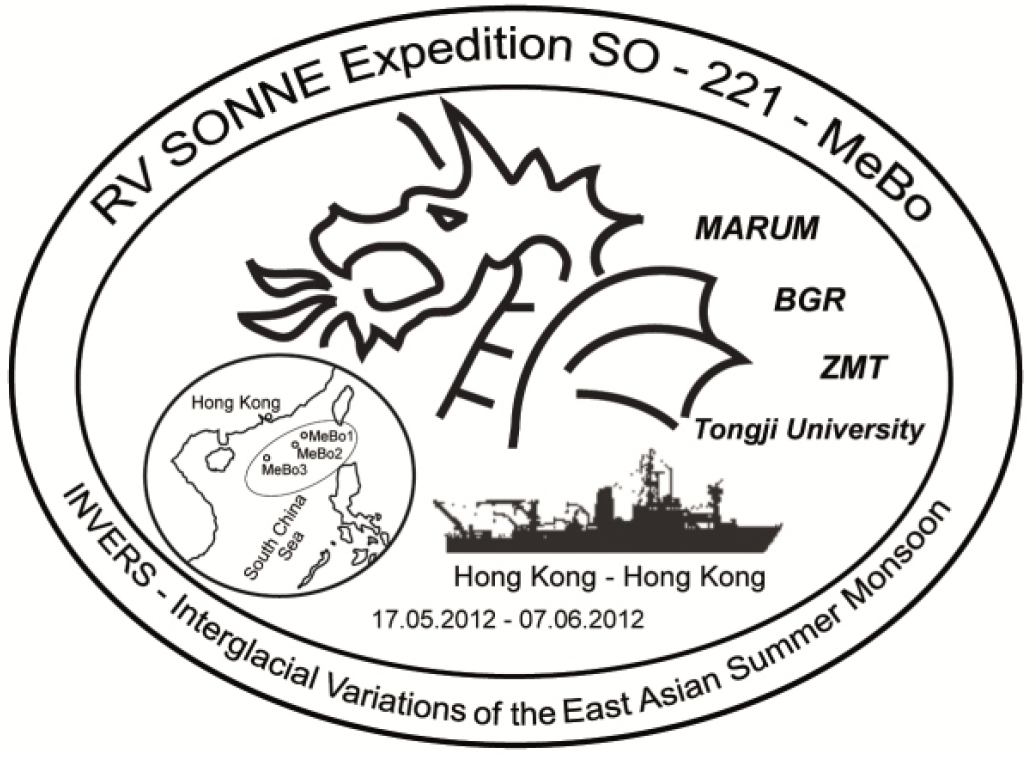2012 05 - R/V Sonne Cruise SO221 - INVERS
 Interglacial variations of the East Asian summer monsoon - South China Sea
Interglacial variations of the East Asian summer monsoon - South China Sea
Hong Kong – Hong Kong (PRC)
17.05.2012 – 07.06.2012
Chief Seismic: Dr. Keil
MTU participants: Dr. Palamenghi, Iliev
 Changes in the East Asian summer monsoon are driven by natural factors, however, in more recent times to an increasing degree also by anthropogenic factors. The relative weighting of these controlling factors needs to be known, in order to prognosticate the variability of precipitation in Central Asia, which is of enormous importance for the development of the regional national economies. During this expedition we sampled highly resolved marine climate archives using the Bremen Sea Floor Drill Rig (MeBo) in the northern South China Sea. Novel proxy approaches are applied to these archives combined with climate modeling that allow to reconstruct the natural variability of the East Asian summer monsoon during the Holocene and last 5 interglacials (MIS 13, 11, 9, 7, 5). We are investigating changes in the vegetation and the hydrological cycle in the catchment area of the Pearl River during these climate periods. A model-based comparison of the natural development during the previous interglacials with the already anthropogenic affected Holocene development aims at assessing the relative weighting of natural and anthropogenic forcings. Thus, INVERS will broaden the knowledge base on climate change in Central Asia and will improve scenarios outlining the future dynamic of the monsoon system.
Changes in the East Asian summer monsoon are driven by natural factors, however, in more recent times to an increasing degree also by anthropogenic factors. The relative weighting of these controlling factors needs to be known, in order to prognosticate the variability of precipitation in Central Asia, which is of enormous importance for the development of the regional national economies. During this expedition we sampled highly resolved marine climate archives using the Bremen Sea Floor Drill Rig (MeBo) in the northern South China Sea. Novel proxy approaches are applied to these archives combined with climate modeling that allow to reconstruct the natural variability of the East Asian summer monsoon during the Holocene and last 5 interglacials (MIS 13, 11, 9, 7, 5). We are investigating changes in the vegetation and the hydrological cycle in the catchment area of the Pearl River during these climate periods. A model-based comparison of the natural development during the previous interglacials with the already anthropogenic affected Holocene development aims at assessing the relative weighting of natural and anthropogenic forcings. Thus, INVERS will broaden the knowledge base on climate change in Central Asia and will improve scenarios outlining the future dynamic of the monsoon system.
This expedition is directly connected with the BMBF research projects "Natural versus anthropogenic controls of past monsoon variability in Central Asia recorded in marine archives (CARIMA)” and "Central Asian Holocene Climate (CAHOL)" as parts of "Central Asia: Monsoon Dynamics and Geo-Ecosystems (CAME)".
Publications
Palamenghi, Luisa, Keil H., Spiess V. (2015) Sequence stratigraphic framework of a mixed turbidite-contourite depositional system along the NW slope of the South China Sea. Geo-Marine Letters 35 (1), 69-75, https://doi.org/10.1007/s00367-014-0385-z.
Bathymetry
Seismic Data Example at MeBo Drill Site GeoB16602
Seismic Profiles
